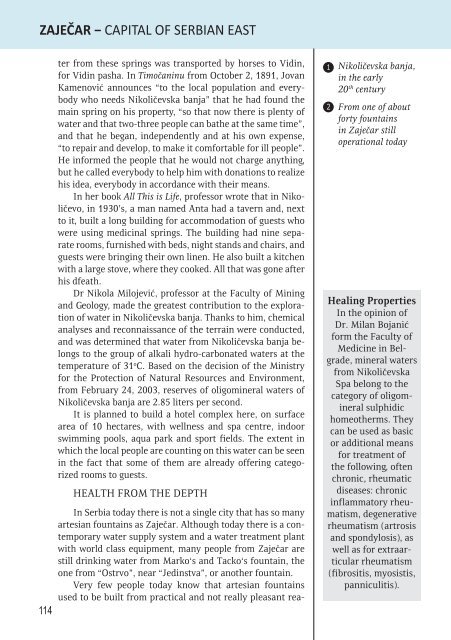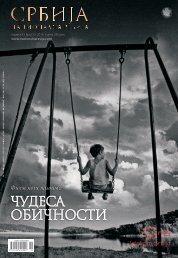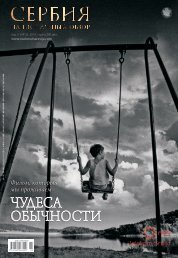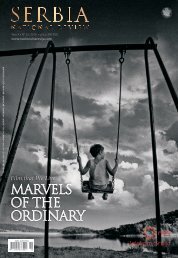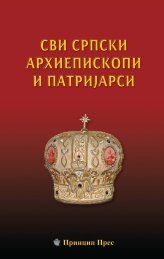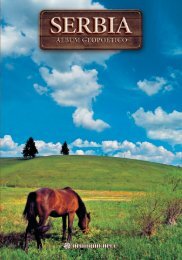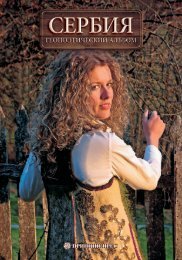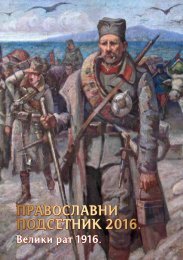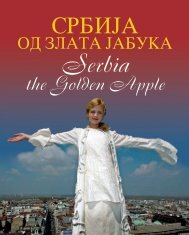Zajecar - engleski - niska rezolucija
Create successful ePaper yourself
Turn your PDF publications into a flip-book with our unique Google optimized e-Paper software.
ZAJEČAR − CAPITAL OF SERBIAN EAST<br />
114<br />
ter from these springs was transported by horses to Vidin,<br />
for Vidin pasha. In Ti mo ča ni nu from October 2, 1891, Jo van<br />
Ka me no vić announces “to the local population and everybody<br />
who needs Ni ko li čev ska ba nja” that he had found the<br />
main spring on his property, “so that now there is plenty of<br />
water and that two-three people can bathe at the same time”,<br />
and that he began, independently and at his own expense,<br />
“to repair and develop, to make it comfortable for ill people”.<br />
He informed the people that he would not charge anything,<br />
but he called everybody to help him with donations to realize<br />
his idea, everybody in accordance with their means.<br />
In her book All This is Life, professor wrote that in Ni koli<br />
če vo, in 1930’s, a man named An ta had a tavern and, next<br />
to it, built a long building for accommodation of guests who<br />
were using medicinal springs. The building had nine separate<br />
rooms, furnished with beds, night stands and chairs, and<br />
guests were bringing their own linen. He also built a kitchen<br />
with a large stove, where they cooked. All that was gone after<br />
his dfeath.<br />
Dr Ni ko la Mi lo je vić, professor at the Faculty of Mining<br />
and Geology, made the greatest contribution to the exploration<br />
of water in Ni ko li čev ska banja. Thanks to him, chemical<br />
analyses and reconnaissance of the terrain were conducted,<br />
and was determined that water from Ni ko li čev ska banja belongs<br />
to the group of alkali hydro-carbonated waters at the<br />
tem pe ra tu re of 31 o C. Based on the decision of the Ministry<br />
for the Protection of Natural Resources and Environment,<br />
from February 24, 2003, reserves of oligomineral waters of<br />
Ni ko li čev ska banja are 2.85 liters per second.<br />
It is planned to build a hotel complex here, on surface<br />
area of 10 hectares, with wellness and spa centre, indoor<br />
swimming pools, aqua park and sport fields. The extent in<br />
which the local people are counting on this water can be seen<br />
in the fact that some of them are already offering categorized<br />
rooms to guests.<br />
HEALTH FROM THE DEPTH<br />
In Serbia today there is not a single city that has so many<br />
artesian fountains as Za je čar. Although today there is a contemporary<br />
water supply system and a water treatment plant<br />
with world class equipment, many people from Zaječar are<br />
still drinking water from Mar ko ‘s and Tac ko ‘s fountain, the<br />
one from “Ostr vo”, near “Je din stva”, or another fountain.<br />
Very few people today know that artesian fountains<br />
used to be built from practical and not really pleasant rea-<br />
1<br />
2<br />
Ni ko li čev ska ba nja,<br />
in the early<br />
20 th century<br />
From one of about<br />
forty fountains<br />
in Zaječar still<br />
operational today<br />
Healing Properties<br />
In the opinion of<br />
Dr. Mi la n Bo ja ni ć<br />
form the Faculty of<br />
Medicine in Belgrade,<br />
mineral waters<br />
from Ni ko li čev ska<br />
Spa belong to the<br />
category of oligomineral<br />
sulphidic<br />
homeotherms. They<br />
can be used as basic<br />
or additional means<br />
for treatment of<br />
the following, often<br />
chronic, rheumatic<br />
diseases: chronic<br />
inflammatory rheumatism,<br />
degenerative<br />
rheumatism (artrosis<br />
and spondylosis), as<br />
well as for extraarticular<br />
rheumatism<br />
(fibrositis, myosistis,<br />
panniculitis).


